5 Easy Tricks to Create Helpful Content Google and Readers Love

Introduction
Ever wondered how to make helpful content that both Google and readers love? You’re in the right place.
Creating great content isn’t rocket science. It’s about understanding what your audience needs and delivering it effectively.
In this guide, we’ll show you 5 easy tricks to make your content stand out. These techniques will help you satisfy both search engines and human readers.
Let’s dive into the strategies that will transform your content from good to great.
Trick 1: Master the Art of Crafting Useful Information
TL;DR:
- Learn to identify and understand your target audience
- Conduct in-depth research to find relevant topics
- Structure your content for easy reading and comprehension
Identify Your Target Audience
Knowing your audience is the first step in creating content that resonates. Start by researching your target demographic. Look into their age, location, job roles, and industry. This information helps you tailor your content to their specific needs.
Next, dig deeper into their interests and pain points. What challenges do they face in their work? What solutions are they seeking? Use tools like social media analytics, customer surveys, and industry reports to gather this information. This research will help you create content that directly addresses their concerns.
Create Audience Personas
Once you have a good understanding of your audience, create detailed personas. These are fictional representations of your ideal readers. Include information such as:
- Name and job title
- Age and location
- Goals and challenges
- Preferred content formats (e.g., blog posts, videos, podcasts)
- Favorite social media platforms
These personas will guide your content creation process. They help you keep your audience in mind as you write, ensuring your content remains relevant and valuable. In the example below, we’ve created a key target example for our own business – you can find the template we used here on Canva.
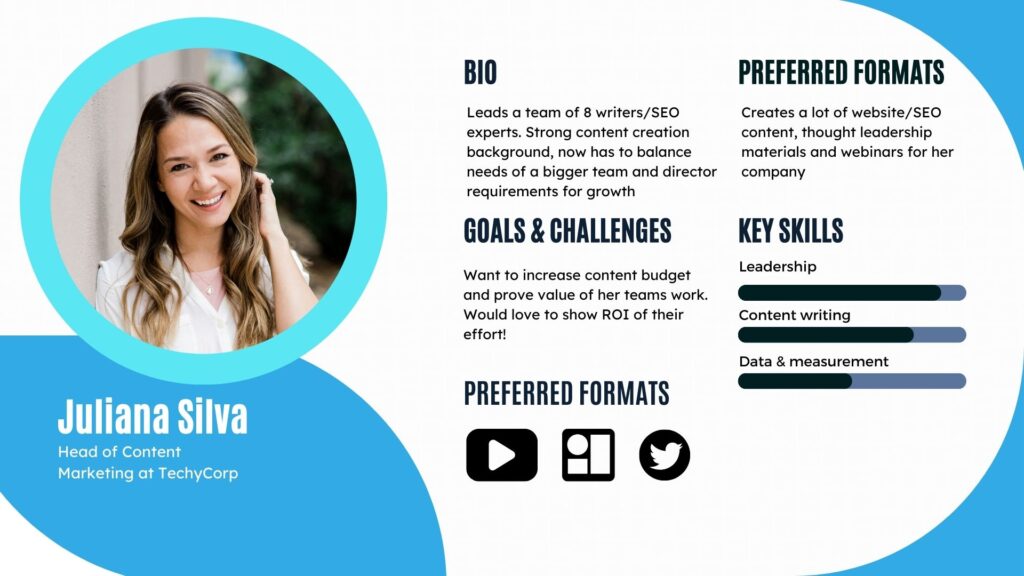
Conduct Thorough Topic Research
With a clear picture of your audience, it’s time to find topics that interest them. Start by using keyword research tools like Google Keyword Planner, SEMrush, or Ahrefs. These tools show you what your audience is searching for online.
Look for keywords with a good balance of search volume and competition. High-volume keywords are popular but often harder to rank for. Low-competition keywords might be easier to rank for but may have less search traffic. Find a balance that works for your content strategy.
Analyse Competitor Content
Next, look at what your competitors are writing about. Visit their blogs and social media profiles. Pay attention to:
- Topics they cover frequently
- Content formats they use (e.g., listicles, how-to guides, case studies)
- Topics that generate high engagement (comments, shares, likes)
This analysis helps you identify gaps in the market. Look for topics your competitors haven’t covered or angles they’ve missed. This is your opportunity to create unique, valuable content that stands out.
Structure Your Content for Easy Consumption
Once you have your topic, it’s time to structure your content. Good structure makes your content easy to read and understand. It also helps search engines interpret your content, which can improve your rankings.
Use Clear Headings and Subheadings
Break your content into logical sections using headings and subheadings. This creates a clear hierarchy of information. It allows readers to quickly scan your content and find the information they need. Use H2 tags for main sections and H3 or H4 tags for subsections.
For example:
[H2] Main Topic
[H3] Subtopic 1
[H4] Detailed Point 1
[H4] Detailed Point 2
[H3] Subtopic 2
This structure helps both readers and search engines understand the organisation of your content.
Incorporate Bullet Points and Numbered Lists
Lists make information easier to digest. Use bullet points for unordered lists and numbered lists for sequential information or steps. For example:
Benefits of structured content:
- Improved readability
- Better retention of information
- Easier scanning for specific details
Steps to create a content structure:
- Outline your main points
- Break down each point into subtopics
- Use headings to organise your content
- Add bullet points or numbered lists where appropriate
Remember, “71% of B2B buyers consume blog content during their buyer journey” (https://optinmonster.com/blogging-statistics/).
By structuring your content well, you make it more likely that these buyers will engage with and benefit from your content.
By mastering these techniques, you’ll create content that’s not only useful but also enjoyable to read. This approach satisfies both your audience and search engines, setting a strong foundation for your content strategy.
Trick 2: Focus on Satisfying User Intent
TL;DR:
- Learn to identify and cater to different search intents
- Match your content to what users are looking for
- Provide clear, actionable solutions to user queries
Understand Different Types of Search Intent
Search intent is the reason behind a user’s online query. It’s crucial to grasp this concept to create content that meets users’ needs. There are three main types of search intent:
Informational Intent
Users with informational intent are looking for answers or knowledge. They might ask questions like “What is SEO?” or “How to bake a cake?” To satisfy this intent:
- Provide clear, concise answers to common questions.
- Use headings and bullet points to break down complex information.
- Include relevant statistics and data to support your points.
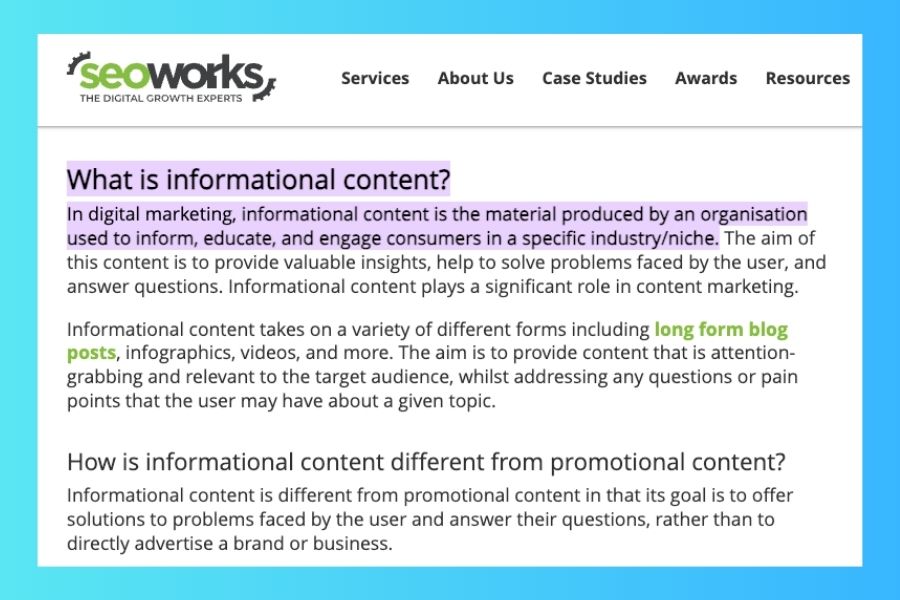
Navigational Intent
Navigational searches aim to find a specific website or page. Examples include “Facebook login” or “Nike customer service.” To cater to this intent:
- Ensure your website’s structure is clear and easy to navigate.
- Use descriptive page titles and meta descriptions.
- Create landing pages for key products or services.
Transactional Intent
Users with transactional intent are ready to make a purchase or take action. Searches might include “buy iPhone 13” or “book hotel in New York.” To address this intent:
- Provide clear pricing information and product details.
- Include prominent call-to-action buttons.
- Showcase customer reviews and ratings.
Align Content with Search Queries
To create helpful content that satisfies user intent, you need to align your content with what users are searching for. Here’s how:
- Use keyword research tools to identify popular search terms in your niche.
- Analyse the top-ranking pages for your target keywords to understand what type of content is performing well.
- Look for “People Also Ask” boxes in search results to find related questions.
Once you’ve gathered this information, structure your content to address these queries directly. For example, if you’re writing about “healthy breakfast ideas,” you might include sections on:
- Quick and easy breakfast recipes
- Nutritional information for common breakfast foods
- Tips for meal prepping breakfast
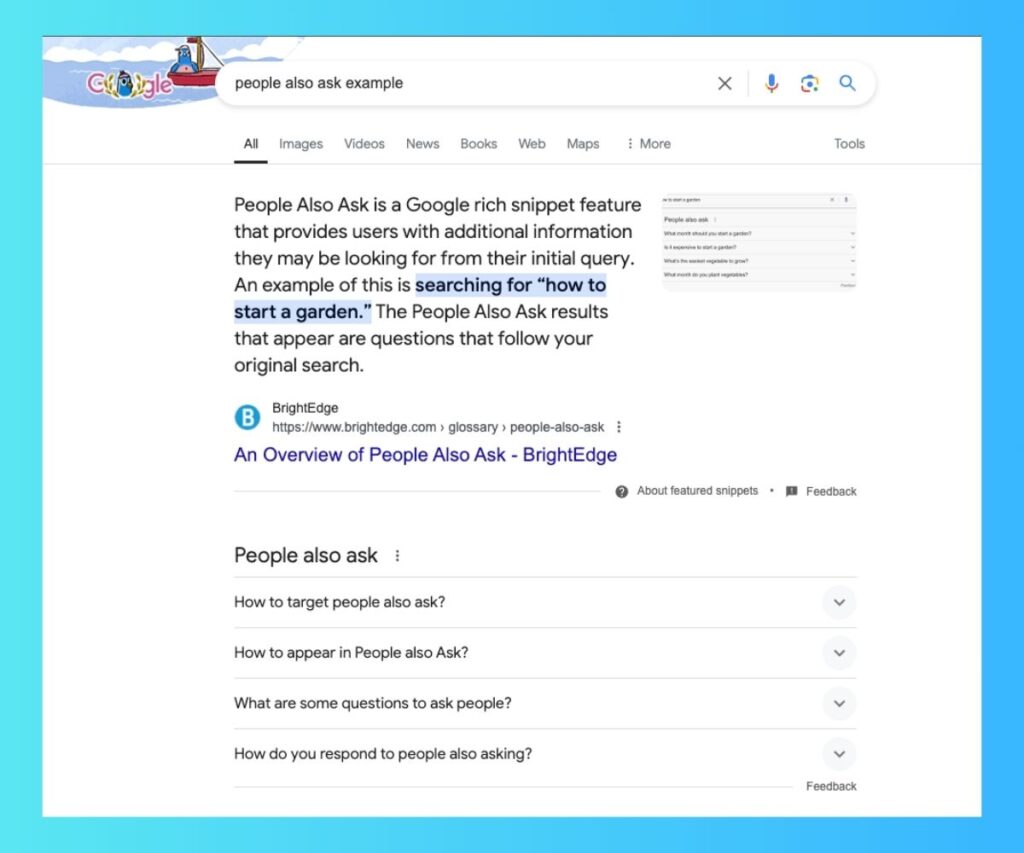
Provide Actionable Solutions
Helpful content goes beyond just providing information—it offers practical, actionable solutions. Here’s how to do it:
Create Step-by-Step Guides
- Break down complex processes into simple, easy-to-follow steps.
- Use numbered lists for clarity.
- Include images or diagrams to illustrate each step visually.
For example, if you’re explaining how to create a social media marketing strategy, you might have steps like:
- Define your target audience
- Set SMART goals
- Choose the right social media platforms
- Create a content calendar
- Develop engaging content
- Monitor and analyse results
Include Practical Examples and Case Studies
Real-world examples help readers understand how to apply the information you’re sharing. To incorporate these effectively:
- Use examples from various industries to make your content relatable to a wider audience.
- Present case studies with clear before-and-after scenarios.
- Highlight key takeaways from each example or case study.
For instance, if you’re discussing the benefits of content marketing, you might include a case study of a small business that increased its website traffic by 200% through consistent blogging. This example from Diggity Marketing is perfect.

By focusing on satisfying user intent, you’re not just creating content—you’re providing value. This approach helps both Google and readers recognise your content as helpful and relevant. In fact, 71% of online marketers describe content creation as their most effective SEO tactic (https://optinmonster.com/blogging-statistics/), highlighting the importance of aligning your content with user needs and search intent.
Remember, helpful content answers questions, solves problems, and guides users towards their goals. Whether you’re writing a blog post, creating a video, or designing an infographic, always ask yourself: “Does this satisfy the user’s intent?” If the answer is yes, you’re on the right track to creating content that both Google and readers will love.
Trick 3: Prioritise Content Quality Metrics
TL;DR:
- Focus on accuracy, relevance, and readability
- Regularly update content to maintain freshness
- Aim for a 9th-grade reading level for wider accessibility
Ensure Accuracy and Reliability
Accuracy is the foundation of high-quality content. It builds trust with your readers and establishes your authority in the subject matter. Here’s how to ensure your content is accurate and reliable:
Fact-check all information
- Cross-reference multiple sources: Don’t rely on a single source for your information. Compare data from at least three reputable sources to ensure accuracy.
- Use primary sources: Whenever possible, go back to the original research or data. Secondary sources can sometimes misinterpret or misrepresent information.
- Set up a fact-checking process: Create a checklist for your team to follow before publishing content. This might include verifying statistics, double-checking names and dates, and confirming quoted statements.
- Use fact-checking tools: Leverage online fact-checking resources like Snopes, FactCheck.org, or PolitiFact for general information. For specific industries, identify authoritative databases or organisations.
- Implement a peer review system: Have a colleague review your content for accuracy. Fresh eyes can catch errors you might have missed.
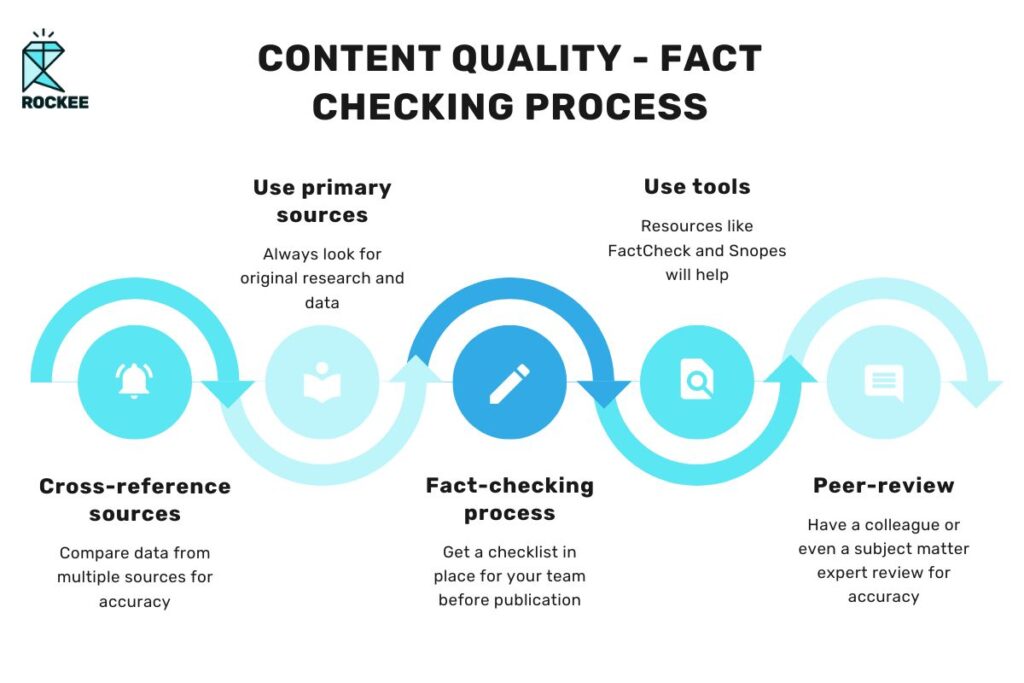
Cite reputable sources and studies
Citing sources adds credibility to your content and allows readers to verify information themselves. Follow these steps:
- Choose authoritative sources: Prioritise peer-reviewed journals, government agencies, and recognised industry experts. Be wary of sources with potential biases.
- Use recent sources: In fast-moving fields, ensure your sources are up-to-date. Generally, aim for sources published within the last 3-5 years.
- Provide proper attribution: Always give credit to the original source. Include author names, publication dates, and direct links where possible.
- Use a consistent citation style: Choose a citation style (APA, MLA, Chicago, etc.) and stick to it throughout your content.
- Balance academic and practical sources: While academic sources provide depth, industry reports and case studies can offer practical insights.
- Create a source list: Maintain a list of go-to sources for your industry. This can save time and ensure consistency across your content.
Maintain Relevance and Freshness
Keeping your content up-to-date is crucial for both search engines and readers. Here’s how to maintain relevance and freshness:
Regularly update content with new information
- Set up a content audit schedule: Review your content at least once every six months. For fast-moving industries, consider quarterly reviews.
- Monitor industry trends: Use tools like Google Trends, industry publications, and social media to stay on top of new developments.
- Update statistics and data: Replace old figures with the most recent available data. This shows readers that your content is current.
- Add new sections: As new subtopics emerge in your field, add them to existing content to keep it comprehensive.
- Refresh examples and case studies: Replace outdated examples with current ones that resonate with your audience.
- Update visuals: Replace old images, infographics, or videos with new ones that reflect current trends and data.
- Add editor’s notes: For significant updates, consider adding a note at the top of the content indicating when and how it was updated.
Remove or update outdated sections
- Identify obsolete information: During your content audit, flag sections that are no longer relevant or accurate.
- Decide whether to update or remove: If the information can be updated with current data, do so. If it’s no longer relevant to your audience, consider removing it entirely.
- Redirect removed content: If you remove entire pages, set up 301 redirects to relevant, up-to-date content to maintain SEO value.
- Archive historical content: For content that’s no longer current but might have historical value, consider moving it to an archive section of your site.
- Update internal links: After removing or updating sections, ensure all internal links are still valid and point to the most relevant content.
- Communicate changes: For significant updates or removals, consider notifying your audience through newsletters or social media.
Optimise for Readability
Readability is key to ensuring your content is accessible and engaging to a wide audience. Here’s how to optimise your content for readability:
Use short paragraphs and sentences
- Aim for 2-3 sentences per paragraph: This creates white space and makes your content less intimidating to read.
- Vary sentence length: Mix short sentences (8-10 words) with medium-length ones (15-20 words) to create rhythm.
- Break up long sentences: If a sentence is over 25 words, consider splitting it into two.
- Use bullet points and numbered lists: These break up text and make information easier to scan.
- Incorporate subheadings: Use H3 and H4 tags to create clear sections within your content.
- Use transition words: Words like “however,” “therefore,” and “consequently” help guide readers through your content.
Aim for a 9th-grade reading level
- Use readability tools: Leverage tools like Hemingway Editor or Grammarly to check your content’s reading level.
- Simplify vocabulary: Replace complex words with simpler alternatives. For example, use “use” instead of “utilise.”
- Explain technical terms: If you must use industry-specific jargon, provide clear, concise definitions.
- Use active voice: Active voice is generally easier to understand than passive voice.
- Avoid long chains of prepositional phrases: These can make sentences hard to follow.
- Read your content aloud: This can help you identify areas where the flow could be improved.
- Get feedback from your target audience: Ask representatives from your target audience to review your content for clarity.
By prioritising these content quality metrics, you’ll create content that not only ranks well in search engines but also provides real value to your readers. Remember, high-quality content that meets user needs is the cornerstone of a successful content strategy.
Trick 4: Implement Engaging Writing Techniques
TL;DR:
- Learn active voice and conversational tone for better reader connection
- Use storytelling to make content relatable and memorable
- Add visual elements to enhance understanding and engagement
Use Active Voice and Conversational Tone
Writing in an active voice and using a conversational tone can transform your content from dull to engaging. This approach helps readers connect with your message and keeps them interested throughout the piece.
Mastering Active Voice
Active voice puts the subject of the sentence in the driver’s seat. It makes your writing clearer, more direct, and easier to understand. Here’s how to use it:
- Identify the subject and verb in your sentence.
- Make sure the subject is performing the action.
- Rewrite passive sentences to be active.
Example: Passive: “The report was written by the team.” Active: “The team wrote the report.”
Practice this technique by reviewing your existing content and rewriting passive sentences. Over time, using active voice will become second nature.
Adopting a Conversational Tone
A conversational tone makes your writing feel more like a dialogue than a lecture. It’s about writing the way you speak, minus the filler words and pauses. Here are some tips:
- Use “you” and “we” to address the reader directly.
- Ask questions to engage the reader.
- Use contractions (e.g., “don’t” instead of “do not”).
- Vary sentence length to create a natural rhythm.
Remember, being conversational doesn’t mean being unprofessional. Maintain a balance between friendly and informative.
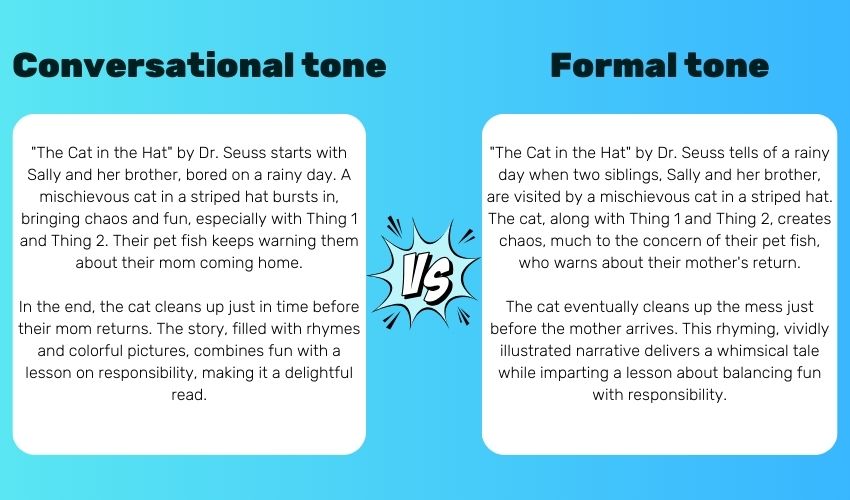
Incorporate Storytelling Elements
Storytelling is a powerful tool for making your content more engaging and memorable. It helps readers connect emotionally with your message and makes complex ideas easier to understand.
Crafting Effective Anecdotes
Anecdotes are short, interesting stories that illustrate a point. They can make your content more relatable and help readers see the practical application of your ideas. Here’s how to create effective anecdotes:
- Keep it brief – aim for 2-3 sentences.
- Make it relevant to your main point.
- Use vivid details to paint a picture.
- End with a clear lesson or takeaway.
Example: “A small business owner I worked with struggled with content creation. She spent hours writing blog posts that no one read. After implementing these engaging writing techniques, her website traffic doubled in just three months.”
Creating Relatable Scenarios
Scenarios help readers imagine themselves in a situation, making your content more personal and applicable. To create relatable scenarios:
- Understand your audience’s challenges and goals.
- Describe a common situation your readers might face.
- Show how your advice or solution applies to that situation.
- Use specific details to make it feel real.
For instance, if writing for small business owners: “Imagine you’re sitting at your desk, staring at a blank screen. You know you need to write a blog post, but the words just won’t come. Sound familiar?”
Add Visual Elements
Visual elements can significantly enhance your content’s engagement and effectiveness. They break up text, illustrate complex ideas, and cater to visual learners.
Choosing Relevant Images and Infographics
Images and infographics can make your content more appealing and easier to understand. Here’s how to use them effectively:
- Select images that directly relate to your content.
- Use high-quality, professional images.
- Create custom infographics to explain complex data or processes.
- Ensure all visuals are properly credited and legally used.
Incorporating Videos
Videos can add depth to your content and cater to different learning styles. To use videos effectively:
- Keep them short – ideally under 2 minutes.
- Ensure they add value and aren’t just repetitive.
- Include captions for accessibility.
- Host videos on platforms like YouTube and embed them in your content.
Using Charts and Graphs
Charts and graphs are excellent for presenting data visually. They can make complex information easy to understand at a glance. To use them effectively:
- Choose the right type of chart for your data (e.g., bar charts for comparisons, line graphs for trends over time).
- Keep designs simple and clean.
- Use colors strategically to highlight important information.
- Always include clear labels and a legend if necessary.
By implementing these engaging writing techniques, you’ll create content that not only informs but also captivates your readers. This approach answers the question “How do I make better content?” by focusing on active engagement, relatability, and visual appeal. Remember, the key to getting better at creating content is practice and consistently applying these techniques to your writing.
Trick 5: Optimise for Search Engines and User Experience
- Learn to create content that both search engines and readers love
- Discover how to improve page speed and mobile responsiveness
- Implement on-page SEO best practices for better visibility
Implement On-Page SEO Best Practices
On-page SEO is key to making your content visible to search engines. It’s about optimising individual web pages to rank higher and earn more relevant traffic. Here’s how to do it:
Use Target Keywords Naturally
- Choose your primary keyword: Select a keyword that best represents your content’s main topic.
- Conduct keyword research: Use tools like Google Keyword Planner or SEMrush to find related keywords.
- Incorporate keywords strategically:
- Place your primary keyword in the first 100 words of your content
- Use keywords in headings (H1, H2, H3)
- Include keywords in image alt text
- Add keywords to the URL structure
- Avoid keyword stuffing: Use keywords naturally and sparingly. Aim for a keyword density of 1-2%.
Optimise Meta Titles and Descriptions
Meta titles and descriptions are crucial for both SEO and click-through rates. Here’s how to optimise them:
- Meta Title:
- Keep it under 60 characters
- Include your primary keyword
- Make it compelling and relevant to the content
- Meta Description:
- Limit to 155-160 characters
- Include your primary keyword
- Write a concise summary of your content
- Add a call-to-action if appropriate
Remember, while optimising for search engines is important, your primary focus should always be on creating valuable content for your readers. 71% of online marketers describe content creation as their most effective SEO tactic.
Improve Page Load Speed
Page speed is a critical factor in both user experience and search engine rankings. A slow website can lead to higher bounce rates and lower conversions. Here’s how to improve your page load speed:
Compress Images and Use Efficient Coding
- Image Compression:
- Use tools like TinyPNG or Squoosh to compress images without losing quality
- Choose the right file format (JPEG for photographs, PNG for graphics with transparency)
- Implement lazy loading for images below the fold
- Efficient Coding:
- Minify CSS, JavaScript, and HTML
- Use a content delivery network (CDN) to serve assets
- Enable browser caching
- Reduce server response time
Minimise Plugins and Third-Party Scripts
- Audit your plugins and scripts:
- List all plugins and third-party scripts on your site
- Identify which ones are essential
- Remove or replace unnecessary or outdated plugins
- Optimise remaining plugins and scripts:
- Update all plugins to their latest versions
- Combine multiple plugins into one if possible
- Defer loading of non-critical JavaScript

Enhance Mobile Responsiveness
With the increasing use of mobile devices for web browsing, mobile responsiveness is no longer optional. It’s a necessity for good user experience and SEO. Here’s how to enhance your site’s mobile responsiveness:
Ensure Content is Easily Readable on All Devices
- Use responsive design:
- Implement a fluid grid system that adjusts to screen size
- Use relative units (%, em, rem) instead of fixed units (px)
- Set appropriate viewport meta tags
- Optimise text for mobile:
- Use a font size of at least 16px for body text
- Maintain adequate line spacing (1.5 times the font size)
- Ensure sufficient contrast between text and background
- Adapt navigation for mobile:
- Implement a mobile-friendly menu (e.g., hamburger menu)
- Make buttons and links large enough for touch interaction (minimum 44×44 pixels)
Test and Optimise for Various Screen Sizes
- Use responsive design testing tools:
- Google’s Mobile-Friendly Test
- Browser developer tools for device emulation
- BrowserStack for real device testing
- Optimise images for different screen sizes:
- Use srcset attribute to provide multiple image sizes
- Implement art direction with the picture element
- Test and adjust:
- Check your site on various devices and screen sizes
- Pay attention to content flow, image scaling, and touch targets
- Make necessary adjustments based on your findings
By implementing these strategies, you’ll create content that not only ranks well in search engines but also provides a great experience for your readers. Remember, the goal is to balance SEO best practices with user-centric design and valuable content.
Advanced Tips for Content Creation Excellence
TL;DR:
- Learn to leverage user-generated content for authenticity
- Implement content personalisation for improved engagement
- Enhance your content strategy with advanced techniques
Leverage User-Generated Content
User-generated content (UGC) is a powerful tool for building trust and credibility. It provides authentic perspectives that resonate with your audience. Here’s how to effectively incorporate UGC into your content strategy:
Incorporate Customer Reviews and Testimonials
- Collect reviews: Set up a system to gather customer feedback regularly. This can be through email follow-ups, on-site prompts, or social media outreach. We’ve always been a fan of ease of use of Reviews.io
- Display reviews prominently: Feature positive reviews on your website, especially on product pages or in dedicated testimonial sections.
- Respond to all reviews: Show that you value customer feedback by responding to both positive and negative reviews professionally.
- Use review snippets: Extract key phrases from positive reviews to use as headlines or callouts in your marketing materials.
- Create review-based content: Compile top reviews into blog posts or infographics to showcase customer satisfaction.
This example from Jimmy’s is perfect. Customer reviews sticking to the header throughout the site, and then product reviews by the pricing and CTA buttons.
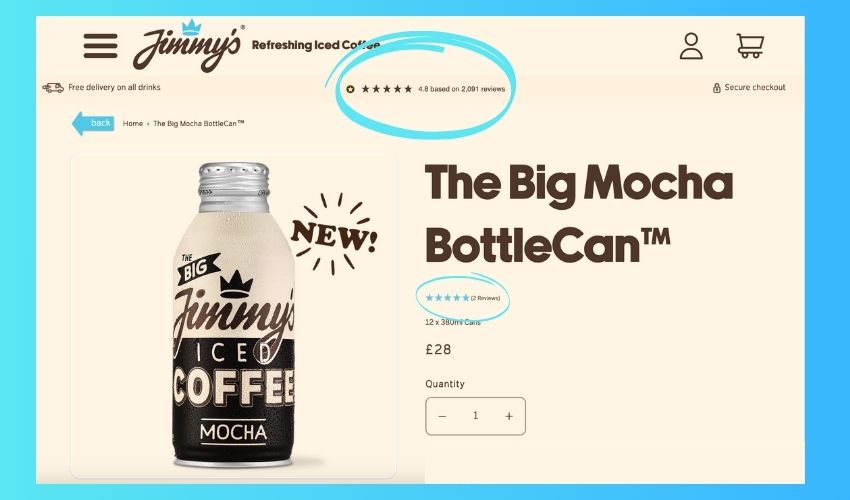
Feature User Success Stories and Case Studies
- Identify success stories: Reach out to customers who have had positive experiences with your product or service.
- Conduct interviews: Ask detailed questions about their experience, challenges, and results.
- Structure the case study:
- Start with the customer’s initial problem
- Explain how your solution was implemented
- Highlight the results and benefits achieved
- Use data and metrics: Include specific numbers to quantify the success.
- Include quotes: Add direct quotes from the customer to add authenticity.
- Create various formats: Develop long-form case studies, video testimonials, and short social media snippets from the same success story.
According to a study, “95.9% of bloggers promote their blog posts via social media” (https://optinmonster.com/blogging-statistics/). This highlights the importance of sharing your user-generated content across various platforms to maximise its reach and impact.
Implement Content Personalisation
Content personalisation tailors your content to individual user preferences and behaviours. This approach can significantly improve engagement and conversion rates. Here’s how to implement personalisation effectively:
Use Dynamic Content Based on User Behaviour
- Collect user data: Implement tools to track user behaviour on your site, including pages visited, time spent, and interaction with content.
- Segment your audience: Group users based on common characteristics or behaviours.
- Create content variations: Develop different versions of your content for each segment.
- Use a content management system (CMS) with personalisation features: Many modern CMS platforms offer built-in personalisation tools.
- Set up rules for content display: Create conditions that determine which content version is shown to each user segment.
- Test and refine: Continuously monitor the performance of your personalised content and adjust as needed.
Tailor Recommendations to Individual Preferences
- Implement a recommendation engine: Use AI-powered tools that analyse user behaviour to suggest relevant content.
- Personalise email campaigns: Segment your email list and send targeted content based on user interests and past interactions.
- Use personalised CTAs: Create dynamic call-to-action buttons that change based on the user’s stage in the customer journey.
- Implement smart forms: Use progressive profiling to gather more information about users over time without overwhelming them.
- Offer personalised product recommendations: Show related products based on browsing history or past purchases.
- Create personalised landing pages: Customise landing page content based on the source of the traffic (e.g., different pages for social media vs. search engine visitors).
Research shows that “60% of marketers have a documented personalisation strategy” (https://optinmonster.com/blogging-statistics/). This underscores the growing importance of personalisation in content marketing strategies.
By leveraging user-generated content and implementing personalisation strategies, you can create more engaging, trustworthy, and effective content. These advanced techniques will help you stand out in a crowded digital landscape and provide more value to your audience.
Troubleshooting Common Content Issues
- Identify and fix low engagement problems
- Resolve keyword cannibalisation for better SEO
- Improve content performance through data-driven strategies
Addressing Low Engagement Rates
Low engagement rates can signal that your content isn’t resonating with your audience. To fix this, you need to analyse key metrics and gather user feedback.
Analyse Bounce Rates, Scroll Rate, and Time on Page
- Access your Google Analytics 4 account and navigate to the Engagement>Pages and Screens section.
- Look at the engagement rate and engagement time for individual pages. A low engagement rate (below 50%) often indicates that users aren’t finding what they need.
- Check the engagement time on page. If it’s less than 30 seconds, your content might not be engaging enough.
- Examine the scroll rate to see how far users are reading with Scrolled users, which only triggers at 90% scroll depth. This is the out-the-box scroll option, for more detailed analysis you can setup triggers and goals via Google Tag Manager – this guide by Analytics Mania has you covered.
- Still unsure what the problem is? Use heat mapping tools like Microsoft Clarity (which is free!) or CrazyEgg for visual representations.
Conduct User Surveys for Feedback
- Create a short survey using tools like Google Forms or Rockee.
- Ask specific questions about content quality, relevance, and areas for improvement.
- Distribute the survey via email to your subscribers or as a pop-up on your website.
- Analyse the responses to identify common themes or issues.
Content Marketing Institute advises, “Conducting user surveys can help you understand your audience better and identify areas where you can improve your content to increase engagement.”
With over 70 million new posts published on WordPress each month, standing out is crucial. Use these insights to refine your content strategy and boost engagement.
Fixing Keyword Cannibalisation
Keyword cannibalisation occurs when multiple pages on your site compete for the same keywords. This can confuse search engines and dilute your SEO efforts.
Audit Content for Overlapping Topics
- Create a spreadsheet listing all your content pieces and their target keywords.
- Use an SEO tool like Ahrefs or SEMrush to identify which pages are ranking for the same keywords.
- Review the content manually to spot thematic overlaps.
- Prioritise the pages that need attention based on their current performance and strategic importance.
Search Engine Journal explains, “Keyword cannibalisation occurs when multiple pages on your website are targeting the same keyword, causing them to compete with each other in search engine rankings.”
Consolidate or Differentiate Similar Content Pieces
- For closely related topics, consider merging the content into a single, comprehensive piece.
- Redirect the less important page to the main piece using a 301 redirect.
- If keeping separate pages, ensure each targets a distinct aspect of the topic or different search intent.
- Update internal links to point to the most relevant page for each keyword.
Search Engine Journal advises, “Consolidating similar content pieces can help you reduce keyword cannibalisation and improve the overall user experience by providing more comprehensive and authoritative content.”
Only 38% of bloggers update older articles, presenting an opportunity to improve your content strategy. By regularly auditing and optimising your content, you can reduce cannibalisation and boost your SEO performance.
By addressing these common content issues, you’ll create a more engaging and SEO-friendly website. Remember, content optimisation is an ongoing process. Regularly review your metrics and be prepared to make data-driven adjustments to your strategy.
Measuring Content Effectiveness
- Learn to track key performance indicators (KPIs) for content success
- Discover essential tools for analysing content performance
- Understand how to use data to improve your content strategy
Key Performance Indicators (KPIs) to Track
Tracking the right KPIs is crucial for understanding how well your content performs. Here are the main metrics to focus on:
Monitor Organic Traffic Growth
Organic traffic is a key indicator of your content’s visibility and relevance. To track it:
- Set up Google Analytics 4 for your website if you haven’t already.
- Navigate to the ‘Acquisition’ section in Google Analytics.
- Select ‘Organic Search’ to view your organic traffic data.
- Look for trends over time, paying attention to spikes or dips in traffic.
- Analyse which pages are driving the most organic traffic.
Keep in mind that 72% of online marketers describe content creation as their most effective SEO tactic (https://optinmonster.com/blogging-statistics/). This underscores the importance of creating high-quality content that attracts organic traffic.
Collect Content Ratings and User Feedback
User feedback provides direct insights into how your audience perceives your content. Here’s how to collect it:
- Implement a rating system at the end of your content pieces (e.g., star ratings or thumbs up/down).
- Use tools like Rockee or SurveyMonkey to create short feedback surveys.
- Add a comments section to your blog posts to encourage discussion – user comments can help with SEO.
- Monitor social media mentions and engagement for your content.
- Regularly review and analyse the feedback to identify patterns and areas for improvement.
Track Conversion Rates and User Engagement Metrics
These metrics help you understand how effectively your content drives desired actions. Follow these steps:
- Set up event and key event tracking in Google Analytics 4 to measure conversions.
- Monitor engagement rates to see if users are engaging with your content.
- Track engagement time on page to gauge how long users spend reading your content.
- Look at scrolled users to see how much of your content users are consuming.
- Analyse click-through rates (CTR) on calls-to-action within your content.
Is content driving pipeline?
For the most advanced teams, the goal is to connect the quality of your content with the impact on business pipeline and revenue. Tools like Dreamdata and Hockeystack are ideal for bigger B2B content teams trying to show the value of their work at the highest level.
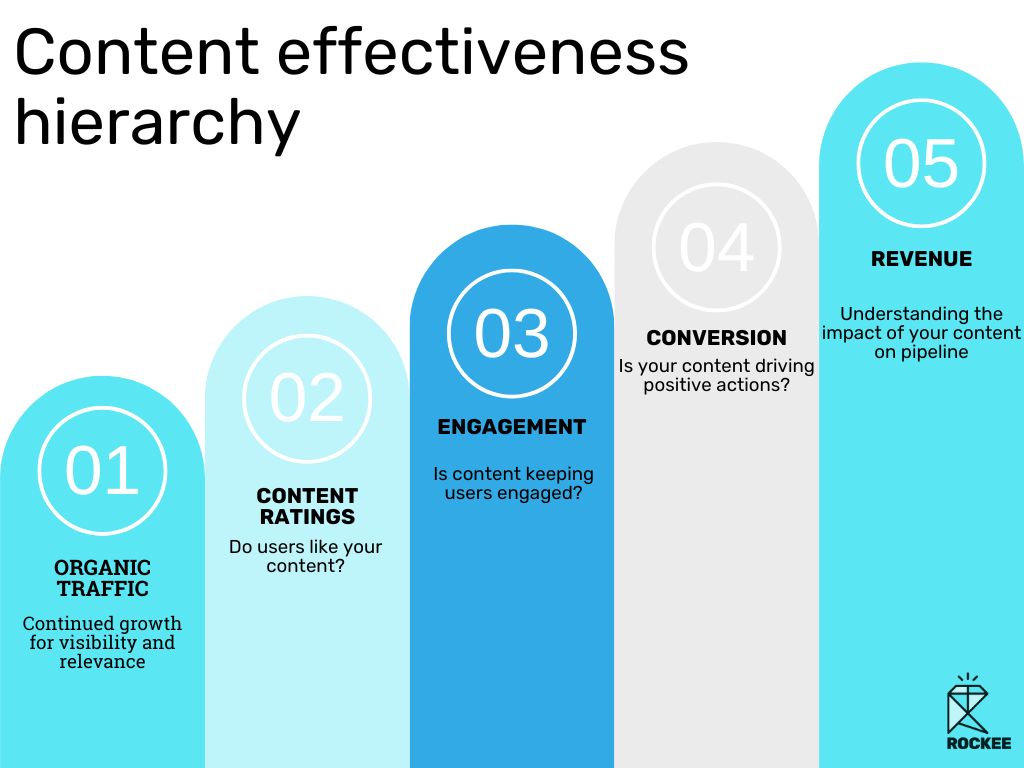
Tools for Content Performance Analysis
To effectively measure your content’s performance, you’ll need the right tools. Here’s an overview of essential platforms:
Google Analytics and Search Console
These free tools from Google provide valuable insights into your website’s performance:
- Google Analytics:
- Set up your account and add the tracking code to your website.
- Use the ‘Behaviour’ section to analyse page views, time on page, and bounce rates.
- Create custom reports to track specific content performance metrics.
- Google Search Console:
- Verify your website ownership and set up your account.
- Use the ‘Performance’ report to see which queries are driving traffic to your content.
- Check the ‘Coverage’ report to ensure all your content is being indexed properly.
SEO Tools for Content Evaluation
Several SEO tools can help you assess and improve your content’s performance:
- SEMrush:
- Use the ‘Content Audit’ tool to analyse your existing content.
- Track keyword rankings for your content pieces.
- Identify content gaps and opportunities for improvement.
- Ahrefs:
- Use the ‘Content Explorer’ to find top-performing content in your niche.
- Analyse backlinks to your content to understand its authority.
- Track keyword positions and identify ranking opportunities.
- Moz Pro:
- Use the ‘Page Optimisation’ feature to improve on-page SEO.
- Track keyword rankings and page authority.
- Analyse your content’s readability and optimise it for better performance.
Tools for Content Feedback and Audience Insights
These tools help you gather direct feedback and understand your audience better:
- Rockee:
- Analyse which content works best for your audience.
- Customise surveys to find out who is reading your content.
- Collect written feedback on how good your content is and use it when optimising.
- Hotjar:
- Use heatmaps to see how users interact with your content.
- Set up feedback polls to gather user opinions.
- Analyse user recordings to understand content consumption patterns.
- Google Trends:
- Identify trending topics in your niche.
- Compare search interest for different content ideas.
- Understand seasonal trends that might affect your content performance.
By consistently using these tools and analysing the data they provide, you can make data-driven decisions to improve your content strategy. Remember, 61% of the most effective B2B content marketers meet with their content team daily or weekly (https://optinmonster.com/blogging-statistics/). This highlights the importance of regular content performance reviews and strategy adjustments.
Your Content Creation Toolkit
Creating content that resonates with both Google and readers isn’t rocket science. It’s about understanding your audience, delivering value, and staying true to best practices. Remember, quality always trumps quantity. Start small, focus on one tactic at a time, and watch your content improve.
Ready to put these tricks into action? Pick one strategy from this guide and apply it to your next piece of content. Which one will you try first?
